汉字的英文介绍 Chinese Character
对汉字的介绍英文作文
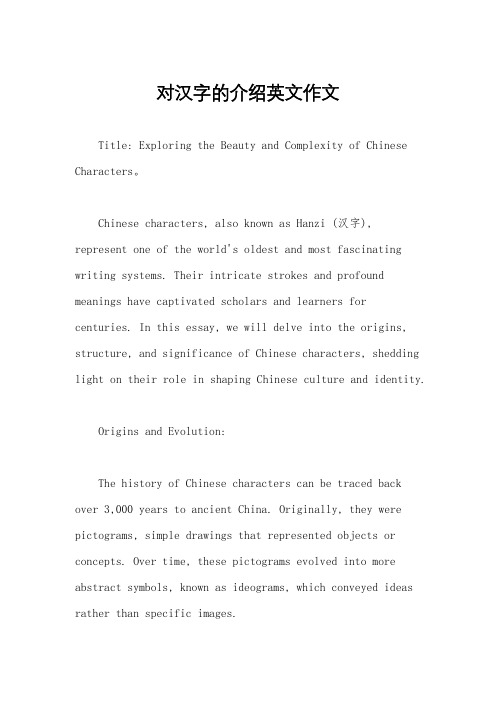
对汉字的介绍英文作文Title: Exploring the Beauty and Complexity of Chinese Characters。
Chinese characters, also known as Hanzi (汉字), represent one of the world's oldest and most fascinating writing systems. Their intricate strokes and profound meanings have captivated scholars and learners for centuries. In this essay, we will delve into the origins, structure, and significance of Chinese characters, shedding light on their role in shaping Chinese culture and identity.Origins and Evolution:The history of Chinese characters can be traced back over 3,000 years to ancient China. Originally, they were pictograms, simple drawings that represented objects or concepts. Over time, these pictograms evolved into more abstract symbols, known as ideograms, which conveyed ideas rather than specific images.One of the earliest forms of Chinese writing is found on oracle bones and bronze vessels dating back to the Shang Dynasty (1600–1046 BCE). These inscriptions provide valuable insights into the language and culture of ancient China. As civilization progressed, the script underwent numerous reforms and standardizations, leading to the establishment of the modern Chinese writing system.Structure and Composition:Chinese characters are composed of strokes, basic units of writing that are combined to form complex characters. There are eight basic types of strokes, includinghorizontal lines, vertical lines, and hooks, each of which contributes to the unique appearance of a character.Characters are typically organized into radicals, fundamental components that carry semantic or phonetic meaning. Radicals serve as building blocks for more complex characters and play a crucial role in character classification and dictionary lookup. For example, thecharacter 水(shuǐ), meaning "water," consists of the radical 氵, which indicates its semantic category.Semantic and Phonetic Elements:Chinese characters often contain both semantic and phonetic elements, allowing for a balance between meaning and pronunciation. Semantic radicals provide clues to the character's meaning, while phonetic components indicate its pronunciation. This dual structure enables Chinese speakers to infer the meaning and pronunciation of unfamiliar characters based on their existing knowledge of the language.For instance, consider the character 妈 (mā), meaning "mother." It consists of the radical 女(nǚ), meaning "woman," and the phonetic component 马(mǎ), which sounds similar to the character's pronunciation.Cultural Significance:Chinese characters are more than just a means ofcommunication; they embody the richness and diversity of Chinese culture. Through their intricate designs and nuanced meanings, characters reflect the values, beliefs, and history of the Chinese people.Moreover, Chinese characters play a vital role in preserving cultural heritage and promoting national identity. They are an integral part of traditional art forms such as calligraphy and seal carving, which require precision, discipline, and aesthetic sensitivity. By mastering these art forms, individuals can deepen their understanding of Chinese culture and express theircreativity through the written word.Challenges and Opportunities:While Chinese characters offer a window into the past and a gateway to cultural exploration, they also present challenges for learners, both native and non-native. The sheer number of characters, estimated to be over 50,000, can be daunting for beginners, requiring years of study and practice to achieve proficiency.However, advancements in technology have made learning Chinese characters more accessible than ever before. Mobile apps, online courses, and digital flashcards provide interactive tools for learners to practice writing, reading, and memorizing characters. Additionally, machine learning algorithms can assist in character recognition and language processing, facilitating communication between speakers of different languages.Conclusion:In conclusion, Chinese characters represent a unique blend of art, language, and culture, encompassing thousands of years of history and tradition. Their intricate structure, rich symbolism, and cultural significance make them a subject of fascination and admiration worldwide. By studying Chinese characters, we gain not only linguistic proficiency but also a deeper appreciation for the enduring legacy of Chinese civilization. As we continue to explore the beauty and complexity of Hanzi, we unlock new insightsinto the human capacity for creativity, expression, and communication across time and space.。
向别人介绍汉字的作文英语
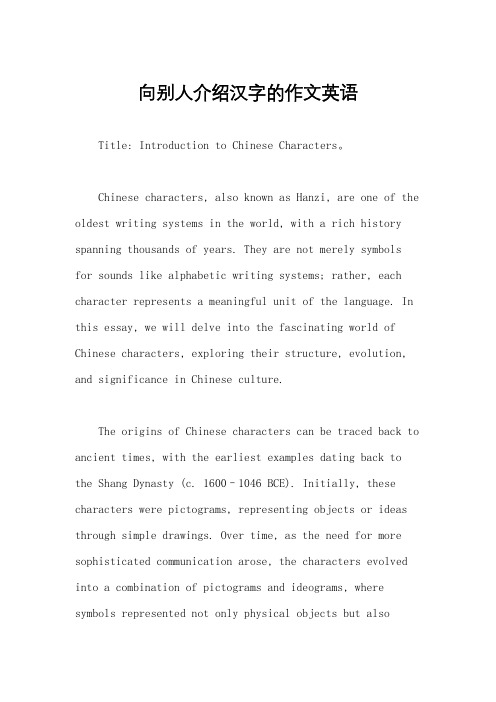
向别人介绍汉字的作文英语Title: Introduction to Chinese Characters。
Chinese characters, also known as Hanzi, are one of the oldest writing systems in the world, with a rich history spanning thousands of years. They are not merely symbolsfor sounds like alphabetic writing systems; rather, each character represents a meaningful unit of the language. In this essay, we will delve into the fascinating world of Chinese characters, exploring their structure, evolution, and significance in Chinese culture.The origins of Chinese characters can be traced back to ancient times, with the earliest examples dating back to the Shang Dynasty (c. 1600–1046 BCE). Initially, these characters were pictograms, representing objects or ideas through simple drawings. Over time, as the need for more sophisticated communication arose, the characters evolved into a combination of pictograms and ideograms, where symbols represented not only physical objects but alsoabstract concepts.One of the distinctive features of Chinese charactersis their stroke order and stroke count. Each character is composed of a specific number of strokes, which are written in a particular sequence. This stroke order is essentialfor proper character formation and readability. For instance, the character for "person" 人 is written with only two strokes, while more complex characters may consist of up to twenty or more strokes.Chinese characters can be classified into several categories based on their structure and meaning. There are pictographic characters, which resemble the objects they represent, such as 日 (sun) and 木 (tree). Ideographic characters convey abstract concepts through symbolic representation, like 上 (up) and 下 (down). Additionally, there are compound characters, which combine two or more simpler characters to create a new meaning, such as 水果(shuǐguǒ fruit), where 水 means "water" and 果 means "fruit."The evolution of Chinese characters has been influenced by various factors, including cultural exchanges, technological advancements, and linguistic changes. As Chinese civilization expanded and interacted with neighboring cultures, new characters were introduced or adapted to accommodate foreign concepts and words. The development of writing tools, such as brush and ink, also influenced the form and style of characters, leading to distinctive calligraphic traditions.Chinese characters play a crucial role in Chinese culture, serving not only as a means of communication but also as a repository of history, literature, and philosophy. The study of characters, known as hanzi xué (汉字学), isan integral part of education in China and other Chinese-speaking regions. It involves memorizing thousands of characters and understanding their meanings, pronunciations, and usage in context.Despite the challenges posed by the complexity of Chinese characters, their beauty and elegance have captivated people around the world. In recent years, therehas been growing interest in learning Chinese and mastering the art of calligraphy. With the rise of globalization, Chinese characters have also gained popularity in tattoo art, fashion design, and digital media, serving as a symbol of cultural identity and aesthetic expression.In conclusion, Chinese characters are not just symbols on a page; they are living artifacts that embody the richness and complexity of Chinese civilization. From their ancient origins to their modern-day usage, Chinese characters continue to inspire and intrigue people worldwide. Whether you are a language enthusiast, a history buff, or simply curious about the world, exploring the world of Chinese characters is a journey worth undertaking. So next time you see a Chinese character, take a moment to appreciate its beauty and significance in shaping the cultural landscape of humanity.。
介绍汉字的英语作文

介绍汉字的英语作文Introduction to Chinese Characters。
Chinese characters, also known as Hanzi, are thewritten symbols used in the Chinese language. They are one of the oldest writing systems in the world and have a rich history dating back thousands of years. Chinese characters are not only a form of communication, but they also carry cultural and artistic significance. In this essay, we will explore the origins, structure, and significance of Chinese characters.The origins of Chinese characters can be traced back to ancient China, where they were developed and refined over centuries. The earliest forms of Chinese characters were found on oracle bones and bronze vessels dating back to the Shang dynasty (c. 1600-1046 BCE). Over time, the characters evolved and became standardized, leading to the complex system of characters used in modern Chinese writing.Chinese characters are unique in that each character represents a morpheme, which is the smallest unit of meaning in a language. This means that each character can convey a specific word or concept, making the Chinese writing system highly efficient and compact. In addition, Chinese characters are logographic, meaning that each character is a visual representation of a word or idea, rather than a phonetic representation as in alphabetic writing systems.The structure of Chinese characters is highly intricate and follows specific rules and principles. Each characteris composed of strokes, which are the basic building blocks of the characters. There are eight basic strokes in Chinese calligraphy, and these strokes are combined in various ways to form the thousands of characters in the Chinese writing system. The order and direction of the strokes are also important, as they can affect the overall appearance and meaning of the character.Chinese characters are not only a means of communication, but they also hold cultural and artisticsignificance. The calligraphy of Chinese characters is considered a highly esteemed art form, and skilled calligraphers are revered in Chinese culture. The beauty and elegance of Chinese calligraphy can be seen in traditional Chinese paintings, poetry, and other forms of art.In conclusion, Chinese characters are a unique and fascinating writing system with a rich history and cultural significance. They are a reflection of the ancient civilization of China and continue to be an important part of Chinese culture today. Whether it is through the beauty of calligraphy or the depth of meaning in each character, Chinese characters are a testament to the creativity and ingenuity of the Chinese people.。
汉字的英文介绍 Chinese Character
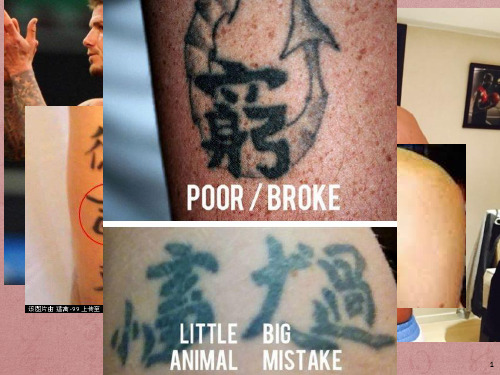
点击添加标题
For example: 水(shuǐ) + 木(mù)
氵+ 木 = 沐(mù) wash
水(shuǐ) + 干(gān)
氵+ 干 = 汗(hàn) sweat
a
11
To write Chinese characters, you should know……
点击添加标题
strokes
点击添加标题
点击添加标题
For example: 日(rì) sun +月(y点u击è)添n加o标on题=
明 (míng ) bright
木(mù) +木(mù) tree, wood = 林 (lín) forest
a
9
huìyì
会意
休
点击添加h标a题ve a rest
点击添加标题
点击添加标题
炎
hot
a
10
点击添加标题
Related to mouth
a
16
a
1
汉(Hàn) 字(Zì)
Chinese Characters
a
2
Do you know how long is Chinese in literature written?
China is the only country in the world with a literature written in one language for more than 3,000 consecutive years.
丿
right-falling
㇏
rising
㇀
a bending stroke 乙、乚、乛
英语作文介绍汉字
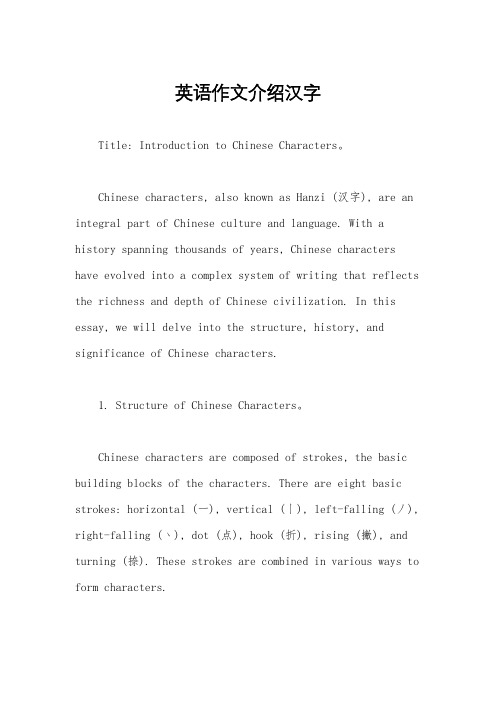
英语作文介绍汉字Title: Introduction to Chinese Characters。
Chinese characters, also known as Hanzi (汉字), are an integral part of Chinese culture and language. With a history spanning thousands of years, Chinese characters have evolved into a complex system of writing that reflects the richness and depth of Chinese civilization. In this essay, we will delve into the structure, history, and significance of Chinese characters.1. Structure of Chinese Characters。
Chinese characters are composed of strokes, the basic building blocks of the characters. There are eight basic strokes: horizontal (一), vertical (丨), left-falling (丿), right-falling (丶), dot (点), hook (折), rising (撇), and turning (捺). These strokes are combined in various ways to form characters.Characters are typically organized into radicals, which are components that give clues to the meaning or pronunciation of the character. Radicals can be thought of as the "building blocks" of characters. For example, the character 水(shuǐ), meaning "water," consists of the radical 氵, which indicates water-related meanings.2. History of Chinese Characters。
介绍汉字 英语作文
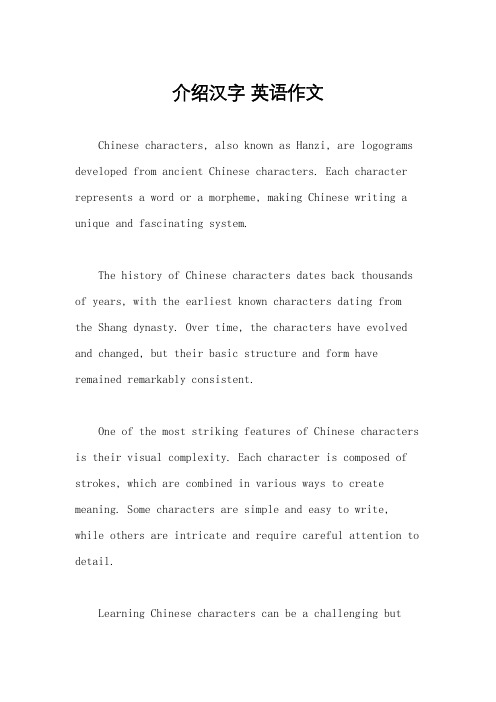
介绍汉字英语作文Chinese characters, also known as Hanzi, are logograms developed from ancient Chinese characters. Each character represents a word or a morpheme, making Chinese writing a unique and fascinating system.The history of Chinese characters dates back thousands of years, with the earliest known characters dating from the Shang dynasty. Over time, the characters have evolved and changed, but their basic structure and form have remained remarkably consistent.One of the most striking features of Chinese characters is their visual complexity. Each character is composed of strokes, which are combined in various ways to create meaning. Some characters are simple and easy to write, while others are intricate and require careful attention to detail.Learning Chinese characters can be a challenging butrewarding experience. There are thousands of characters to memorize, each with its own pronunciation and meaning. However, once you master the basics, you can unlock a whole new world of communication and understanding.In addition to their practical use in writing, Chinese characters also have cultural significance. They are often used in calligraphy, painting, and other forms of art, and are considered a symbol of Chinese culture and heritage.Overall, Chinese characters are a fascinating and essential part of Chinese language and culture. Whether you are learning Chinese for practical reasons or simply out of curiosity, delving into the world of Hanzi is sure to be a rewarding experience.。
中国汉字英文介绍Chinese Characters

English for graduates majoring in Teaching Chinese to Speakers of Other LanguagesOrigin of Chinese CharactersFrom /08olympics/2008-07/09/content_136328.htm Different from Western characters, Chinese characters are square and indicate either pronunciation or meaning or both. Chinese characters provide a convenient tool for imagery thinking.With language, ancient humans began accumulating knowledge through which human culture came forth. With characters, they recorded the language and communicated with each other, which distinguished man from animals. It is characters that drew a line between the primitive and civilized periods of human society.There are various sayings in ancient Chinese documents concerning the origin of Chinese characters, such as "tie knots(结绳)," the "Eight Diagrams(八卦)," "picture," and "carved characters," among others. The legendary story about Cang Jie creating characters is generally recorded in ancient books. According to ancient records, Chinese characters were created by Cang Jie, a history officer of the legendary Yellow Emperor(黄帝).Huainanzi (Masters in the Kingdom of Huainan) says that it was because of the characters Cang Jie made that the Heaven rained grains and ghosts cried at night. Xun Zi and Shi Jing (The Book of Odes颂歌) and other ancient books also record the legend of Cang Jie creating Chinese characters. By the Qin (221-206BC) and Han (206BC-220AD) dynasties, the legend had become more widespread and had more far-reaching(深远的) influence.Historians in the past once tried to prove whether there was a person named Cang Jie in history, and if he did exist, when he lived, but they failed to draw a conclusion due to lack of irrefutable(adj.不能反驳的, 不能驳倒的)proof.Some people guessed that Cang Jie was the historiographer(历史学家;史料编纂者)of the Yellow Emperor. Xunzi thought Cang Jie must have been a prehistoric wise man who sorted out and standardized the characters that had already been in use.Evidently the legend of Cang Jie cannot be accepted as the truth, forany script can only be a creation developed by people to meet the needs of social life over a long period of trial and experiment. Chinese characters are a huge and complicated system, and they could only have come into being after a long period of creation and development.According to modern researchers, the ancestors of the Chinese people tied knots in rope to record events. Later, they adopted sharp weapons to inscribe(雕、刻)signs, and developed the earliest form of Chinese characters. Archeologists(考古学家)have found inscribed signs on Neolithic(['niə'lɪθɪk]新石器时代的)pottery(陶器)shards(碎片)in Banpo Village in Shaanxi Province. These signs, dating back to some 6,000 years ago, were possibly the seeds of later Chinese characters.Inscribed signs, a little younger than those found in Banpo Village, were also found on pottery along the lower reaches of the Yellow River (黄河下游). There, archeologists found a sign with shapes of the moon and a five-peak mountain underneath a circle. Experts in ancient characters say the pictograph(['pɪktəgrɑːf] n.象形文字, 古代石壁画)symbolizes the interval(距离,间隔)in which the moon disappears and the sun rises. Mythology([mɪ'θɒlədʒɪ]神话学)researchers have another interpretation. Their understanding is that the moon shape symbolizes the red clouds as the sun rises, and thus the picture portrays([pɔː'treɪ]描绘)a sunrise over the sea.Most of the signs inscribed on pottery were painted red, creating an imposing(adj.使人难忘的, 壮丽的)and mysterious impression. The hypothesis is that pictographs were used in sacrificial rituals(['rɪtʃʊəl]宗教仪式)dedicated to(献给)the sunrise or as prayers for good harvests. They were inscribed in an orderly way, and the strokes(笔画)are full of strength. Similar signs and designs have been found in other regions in China, indicating they had become generally recognized. These are the earliest symbols, or pictographs, in China and are more than 5,000 years old.In Qinghai Province in western China, pottery objects of approximately the same period and inscribed with images of birds, insects and animals have been unearthed(掘出). These, too, are regarded as pictographs. According to philologist(文献学者;语言学者)Tang Lan(唐兰), Chinese characters originated from pictures; The older the characters, the more they look like pictures. Since pictures have no fixed forms, the ancient Chinese characters were generally free in form.Xu Shen, a philologist of the Han Dynasty (206BC-220AD), divided Chinese characters into six categories. Modern scholars have since reduced them to three types, of which the pictographic character is one. The picture signs are the embryos(['embrɪəʊ]胚胎)of both calligraphy and painting, which gave rise to the Chinese saying that calligraphy and painting have the same origin. At first, the pictographic characters differed from region to region. As time went by, however, they become more standardized, abstract and united, and the earliest Chinese written language, Jiaguwen (shell and bone writing) appeared.Very important website: /index.htmNote: omniglot=omni+glot;omni=(Greek) all;glot=(Greek) language (see English glossary);omniglot=all languages.Origins of writing in ChinaFrom /writing/chinese.htmMost linguists believe that writing was invented in China during the latter half of the 2nd millennium BC and that there is no evidence to suggest the transmission of writing from elsewhere. The earliest recognizable examples of written Chinese date from 1500-950 BC (Shang dynasty) and were inscribed on ox scapulae and turtle shells - "oracle bones".In 1899 a scholar from Beijing named Wang Yirong noticed symbols that looked like writing on some "dragon bones" which he had been prescribed by a pharmacy. At that time "dragon bones" were often used in Chinese medicine and were usually animal fossils. Many more "oracle bones" were found in the ruins of the Shang capital near Anyang in the north of Henan province.The script on these "oracle bones" is known as 甲骨文(jiăgŭwén) - literally "shell bone writing". They were used for divination, a process which involved heating them then inspecting the resulting cracks to determine to answers to one's questions. The bones were then inscribed with details of the questions and the answers. Most of the questions involved hunting, warfare, the weather and the selection of auspicious days for ceremonies.A collection of oracle bones in the National Palace Museum near Taipei.Recently archaeologists in China have unearthed many fragments of neolithic pottery, the oldest of which date from about 4800 BC, inscribed with symbols which could be a form of writing. None of these symbols resemble any of the Shang characters and the likelyhood of deciphering them is remote given the paucity of material.The Chinese writing systemChinese is written with characters which are known as 漢字[汉字] (hànzi). The characters were originally pictures of people, animals or other things, but over the centuries they have become increasingly stylized and no longer resemble the things they represent. Many characters have been combined with others to create new ones.Until the early 20th century, Classical Chinese, 文言(wényán), was the main form of writing in China. It was standardized during the late Han Dynasty (25-220 AD) and was also used in Korea, Japan and Vietnam before they developed their own writing systems.In Classical Chinese most words were monosyllabic and written with a single character. However, during the 1920s a new form of written Chinese modelled on spoken Mandarin was developed. Most Chinese publications since then have been written in this form, which is known as 白話[白话] (báihuà), though Classical Chinese constructions and especially proverbs are still used to some extent.In spoken Chinese, words are made up of one, two or more syllables. Each of the syllables is written with a separate character. Each character has its own meaning, though many are used only in combination with other characters.Every character is given exactly the same amount of space, no matter how complex it is. There are no spaces between characters and the characters which make up multi-syllable words are not grouped together, so when reading Chinese, you not only have to work out what the characters mean and how to pronounce them, but also which characters belong together.How many characters?The Chinese writing system is an open-ended one, meaning that there is no upper limit to the number of characters. The largest Chinese dictionaries include about 56,000 characters, but most of them are archaic, obscure or rare variant forms. Knowledge of about 3,000 characters enables you to read about 99% of the characters used in Chinese newspapers and magazines. To read Chinese literature, technical writings or Classical Chinese though, you need to be familiar with at least 6,000 characters.UsageCharacters can be used on their own, in combination with other characters or as part of other characters.StrokesFrom /writing/chinese.htmChinese characters are written with the following twelve basic strokes:A character may consist of between 1 and 64 stokes. The strokes are always written in the same direction and there is a set(固定的)order to write the strokes of each character. In dictionaries, characters are ordered partly by the number of stokes they contain.NotesThe 39-stroke character (3 x thunder) means "the sound of thunder" and is always written doubled (靐靐). The 48-stroke character (3 dragons) means "the appearance of a dragon walking".HomophonesThere are approximately 1,700 possible syllables in Mandarin, which compares with over 8,000 in English. As a result, there are many homophones - syllables which sound the same but mean different things. These are distinguished in written Chinese by using different characters for each one.Not all the following characters are pronounced with the same tone, so to Chinese ears they sound different. To Western ears however they all sound the same. These syllables can be distinguished in speech from the context and because most of them usually appear in combination with other syllables.If you look closely, you will notice that some of the characters above have parts in common. These parts give you a clue to how to pronounce the characters.More examples of homophonesIt is even possible to write a text in Chinese using on one sound, pronounced with different tones, of course. This is exactly what Chinese linguist, Zhao Yuanren, did when he wrote the "Story of Shi Eating the Lions" using nothing but the sound 'shi'. The story makes sense in written form, but is impossible to understand when read aloud.You can see and hear the story on:/onlinelit/stonelion.html施氏食獅史shi1 shi4 shi2 shi1 shi3Story of Shi Eating the Lions石室詩士施氏, shi2 shi4 shi1 shi4 shi1shi4,A poet named Shi lived in a stone room,嗜獅,誓食十獅. shi4 shi1, shi4 shi2 shi2shi1.fond of lions, he swore that he would eat tenlions.氏時時適市視獅. shi4 shi2 shi2 shi4 shi4shi4 shi1.He constantly went to the market to look forten lions.十時,適十獅適市. shi2 shi2, shi4 shi2 shi1shi4 shi4.At ten o'clock, ten lions came to the market是時,適施氏適是市. shi4 shi2, shi4 shi1 shi4shi4 shi4 shi4.and Shi went to the market.氏視是十獅,恃矢勢, shi4 shi4 shi4 shi2 shi1,shi4 shi3 shi4,Looking at the ten lions, he relied on hisarrows使是十獅逝世. shi3 shi4 shi2 shi1 shi4shi4.to cause the ten lions to pass away.氏拾是十獅屍, 適石室. shi4 shi2 shi4 shi2 shi1shi1, shi4 shi2 shi4.Shi picked up the corpses of the ten lions andtook them to his stone room.石室濕,氏使侍拭石室. shi2 shi4, shi1, shi4 shi3shi4 shi4 shi2 shi4.The stone room was damp. Shi ordered aservant to wipe the stone room.石室拭,氏始試食十獅屍. shi2 shi4 shi4, shi4 shi3shi4 shi2 shi2 shi1 shi1.As the stone den was being wiped, Shi beganto try to eat the meat of the ten lions.食時, 始識十獅屍, shi2 shi2, shi3 shi4 shi4shi2 shi1 shi1,At the time of the meal, he began to realizethat the ten lion corpses實十石獅屍. shi2 shi2 shi2 shi1 shi1. were in fact were ten stone lions.試釋是事. shi4 shi4 shi4 shi4 Try to explain this matter.Compound wordsChinese verbs and adjectives generally consist of one character (syllable) but nouns often consist of two, three or more characters (syllables):Simplified Chinese charactersThe Simplified script (a.k.a.<also known as又名> Simplified Chinese) was officially adopted in the People's Republic of China in 1949 in an effort to eradicate(根除)illiteracy. The simplified script is also used in Singapore but the older traditional characters are still used in Taiwan, Hong Kong, Macau and Malaysia.A second round of simplifications which was published in 1977 but proved very unpopular and was abandoned in 1986.About 2,000 characters have been simplified in a number of different ways (the simplified characters are shown in red):Many simplified characters are based on commonly used abbreviations:Others retain only one part from the traditional character.Some replace the phonetic element of the traditional character with a simpler one that is pronounced in the same or in a similar way:In some cases, several traditional characters are represented by one simplified character:Recently the traditional characters have started to make a come back, particularly in southern China.Sample text in ChineseHànyŭ pīnyīn transliterationRénrén shēng ér zìyóu, zài zūnyán hé quánlì shàng yīlǜpíngdĕng. Tāmen fùyŏu lĭxìng hé liángxīn, bìng yīng yĭ xiōngdì guānxì de jīngshén hùxiāng duìdài.Direction of writingTraditionally Chinese was written from right to left in vertical columns. The first publication in Chinese using horizontal (left to right) text was Robert Morrison's Dictionary of the Chinese language, published in 1815–1823 in Macau. The increasing use of words in Western languages, especially English, in Chinese texts from the early 20th century made horizontal texts more popular.Since 1949 horizontal writing has become the standard in the PRC, and all PRC newspapers changed from vertical to horizontal text in 1956, though some headlines are written vertically, as are inscriptions(题字)of signs on most state organizations.The horizontal writing of Chinese is normal in Singapore, and it has been gradually adopted in Hong Kong, Macao and in overseas Chinese communities since the 1990s.Vertical text remains popular in Taiwan however, though horizontal text is used as well. In Taiwan newspapers and magazines with vertical text, some of the headlines and titles are written horizontally right to left across the top of the main text.Use of Chinese characters for other languagesChinese characters are used to write Modern Standard Chinese, which is based largely on spoken Mandarin. Other varieties of Chinese, especially Cantonese, are sometimes written with Chinese characters, or with a combination of characters and words in the Latin alphabet. Some of the characters used are archaic(陈旧的,古老的)or invented specifically for these languages.Chinese characters have been used to write Japanese and Korean and Vietnamese. They are still used in written Japanese, in combination with hiragana(平假名-日文字母的草体)and katakana(片假名), and to a much lesser in written Korean, while Vietnamese is now written with the Latin alphabet.Evolution of Chinese CharactersFrom /writing/chinese_evolution.htmThe images(图象)below illustrate how a number of Chinese characters have changed over time from their earliest known pictographic(象形文字的)forms, to the versions used today.The Large Seal and Small Seal scripts are still used to write names on personal name chops(官印), and are also occasionally used to write company names on buildings, stationery(文具), name cards, etc.The Grass script (a.k.a. <also known as又名> Cursive script) is used mainly for Chinese calligraphy. Each character is written with one continuous stroke, which enables very rapid writing, though characters written in this way are difficult to read. Legibility(易辨性)is not a primary concern for Chinese calligraphers, instead they aim to produce calligraphy that is aesthetically(审美地)pleasing.The Simplified script(a.k.a. Simplified Chinese), was officially adopted in the People's Republic of China in 1949 in an effort to eradicate illiteracy. It is also used in Singapore.Sample textsSmall Seal Script (小篆)Clerical Script (隸書)Standard Script with zhùyīn fúhào (楷書)Running script (行書)Grass scriptSimplified characters (简体字)。
外国人介绍汉字英语作文
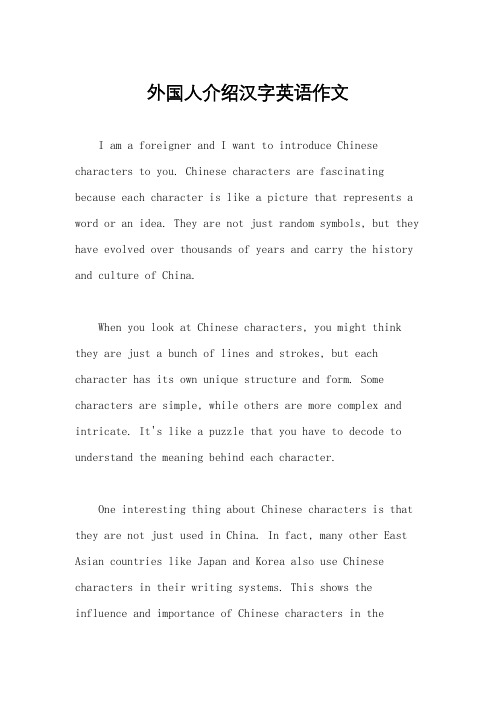
外国人介绍汉字英语作文I am a foreigner and I want to introduce Chinese characters to you. Chinese characters are fascinating because each character is like a picture that represents a word or an idea. They are not just random symbols, but they have evolved over thousands of years and carry the history and culture of China.When you look at Chinese characters, you might think they are just a bunch of lines and strokes, but each character has its own unique structure and form. Some characters are simple, while others are more complex and intricate. It's like a puzzle that you have to decode to understand the meaning behind each character.One interesting thing about Chinese characters is that they are not just used in China. In fact, many other East Asian countries like Japan and Korea also use Chinese characters in their writing systems. This shows the influence and importance of Chinese characters in theregion.Learning Chinese characters can be challenging, butit's also very rewarding. Once you start to recognize and understand the characters, you will feel a sense of accomplishment and pride. It's like unlocking a secret code that allows you to access a whole new world of language and communication.Chinese characters are not only beautiful, but they also have deep meanings and symbolism. Each character tells a story and carries the wisdom of the Chinese people. It's like a window into the rich and ancient culture of China, and by learning Chinese characters, you can gain a deeper understanding and appreciation of this amazing culture.In conclusion, Chinese characters are an integral part of Chinese culture and language. They are not just symbols on a page, but they represent the history, traditions, and values of the Chinese people. Learning Chinese characters is not just about mastering a writing system, but it's also about immersing yourself in a whole new world of beauty andmeaning. So, next time you see a Chinese character, take a moment to appreciate its elegance and significance.。
介绍汉字英语作文

介绍汉字英语作文Chinese characters, known as Hanzi in Mandarin, are the building blocks of the Chinese writing system and play a significant role in the culture and history of China. While English composition typically focuses on the Latin alphabet, an increasing number of English language learners are incorporating elements of Chinese characters into their writing as a means of cultural expression and linguistic diversity. This essay will explore the history of Chinese characters, their structure, and how they can be creatively integrated into English compositions.History and OriginChinese characters have a history that dates back over 3,000 years to the Shang Dynasty. They are logograms, meaning each character represents a word or a meaningful component of a word. The evolution of Hanzi has seen various stages, from the intricate Oracle Bones and Bronze inscriptions to the more simplified and standardized forms used today, such as Simplified Chinese in Mainland China and Traditional Chinese in Hong Kong, Taiwan, and Macau.Structural CharacteristicsThe structure of Chinese characters is complex and can be categorized into six main types: pictographs, simple ideographs, compound ideographs, phono-semantic compounds,phonograms, and derivative characters. Each character is a unique blend of form and meaning, often reflecting thenatural world, human activities, or abstract concepts.Integration into English CompositionIncorporating Chinese characters into English writing can be a powerful tool for enriching the text. Here are a few ways to do so:1. Cultural Context: Use Hanzi to provide cultural context or to highlight the origin of certain concepts that are more poignant in Chinese.2. Decorative Elements: Employ Chinese characters as decorative elements in titles, headings, or as part of graphic design within the composition.3. Poetic License: In poetry or creative writing, Hanzi can add a layer of depth and visual interest, especially when used to contrast with the fluidity of English script.4. Educational Purposes: For compositions aimed at teaching or informing about Chinese language and culture, including Hanzi can be both educational and engaging.5. Personal Expression: Writers with a background in Chinese can use Hanzi to express personal identity or to connect with their heritage.Challenges and ConsiderationsIntegrating Chinese characters into English compositions can pose challenges, such as readability for a non-Chinese audience and the potential for misinterpretation. It is essential to consider the audience's familiarity with Chinese characters and to provide appropriate context or translations when necessary.ConclusionThe inclusion of Chinese characters in English writing is a testament to the growing global interest in Chinese language and culture. When used thoughtfully, Hanzi can enhance the aesthetic and intellectual depth of an English composition, offering readers a glimpse into a rich and ancient writing system that continues to evolve and influence the world today.。
汉字的英文介绍 Chinese Character(课堂PPT)
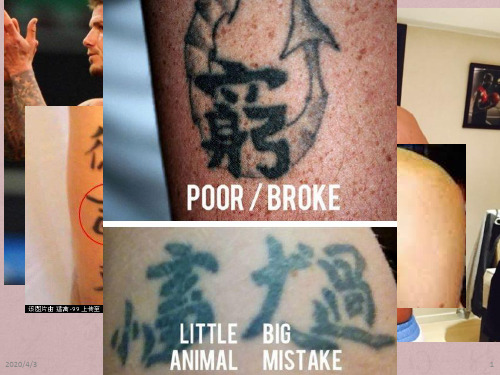
点击添up加标题
点击添加标题
down
木(mù) + 一=本(běn)
tree
root
2020/4/3
LO: To learn to talk about jobs/workplaces and where people do things
last
8g
3. Another method of creating new characters is to integrate two or more existi点ng击c添h加a标ra题cters to create a new character with a new meaning.
2020/4/3
1
2020/4/3
2
Do you know how long is Chinese in literature written?
China is the only country in the world with a literature written in one language for more than 3,000 consecutive years.
2020/4/3
刀(d点ā击o添) 加+标丶题=刃(rèn)
knife
点击添加标题
blade
木(mù) + 一=本(běn)
tree
root
LO: To learn to talk about jobs/workplaces and where people do things
7
one
点击添加t标w题o
5
xiàngxíng
Pictograms
1. Pictograms characters derive from pictures, they have been standardize点d,击s添im加p标li题fied, and stylized to make them easier to write, and their derivation is there点fo击re添n加o标t 题always obvious. Examples include for sun for 点击添加标m题oon, and ľ for tree.
给外国人介绍一个中国汉字或成语英语作文

给外国人介绍一个中国汉字或成语英语作文Chinese characters are the foundation of the written Chinese language, with a history spanning thousands of years. Each character is a unique symbol that represents a word or concept, and they are renowned for their beauty, complexity, and depth of meaning. One particularly fascinating Chinese character is "家" (jiā), which means "family" or "home."The character "家" is composed of two parts: the radical "宀," which represents a roof or shelter, and the phonetic component "豕," which originally depicted a pig. This combination of elements reflects the traditional Chinese concept of the family as the basic unit of society, with the home serving as a place of refuge and nourishment, much like a pig in its sty.At its core, the character "家" embodies the idea of a safe and nurturing environment, a place where one can find comfort, belonging, and a sense of identity. It represents the fundamental human need for a stable and supportive foundation, a place where one can grow, thrive, and cultivate meaningful relationships.In the Chinese language and culture, the concept of "family" extends far beyond the nuclear family unit. It encompasses a broader network of kinship, including extended family members, ancestors, and even close friends who are considered part of the familial circle. This holistic view of the family is deeply rooted in Confucian philosophy, which emphasizes the importance of filial piety, respect for elders, and the harmonious functioning of the family as the cornerstone of a stable society.The character "家" also carries symbolic significance in Chinese art, literature, and daily life. In traditional Chinese architecture, the family home is often designed with a central courtyard, representing the idea of the family as a self-contained and self-sustaining unit. The character is also a common motif in Chinese calligraphy and painting, where its elegant and balanced strokes are celebrated as a reflection of the harmony and stability of the family.Moreover, the character "家" is a key component in many Chinese idioms and proverbs, further highlighting its cultural significance. For example, the idiom "温暖如家" (wēnnuǎn rú jiā), which means "as warm as home," conveys the sense of comfort, security, and unconditional love associated with the family. Another idiom, "四世同堂" (sì shì tóng táng), literally translates to "four generations under one roof," and celebrates the ideal of a multi-generational householdliving in harmony.Beyond its linguistic and cultural importance, the character "家" also holds deep personal significance for many Chinese individuals. It serves as a powerful symbol of one's roots, identity, and sense of belonging. For those who have immigrated or lived abroad, the character can evoke a profound longing for the familiar comforts and traditions of their ancestral home.In conclusion, the Chinese character "家" is a rich and multifaceted symbol that encapsulates the essence of family, home, and the deep-rooted cultural values that have shaped the Chinese civilization for millennia. Its elegance, complexity, and profound significance make it a truly remarkable and captivating aspect of the Chinese language and cultural heritage.。
向外国人介绍汉字英语作文
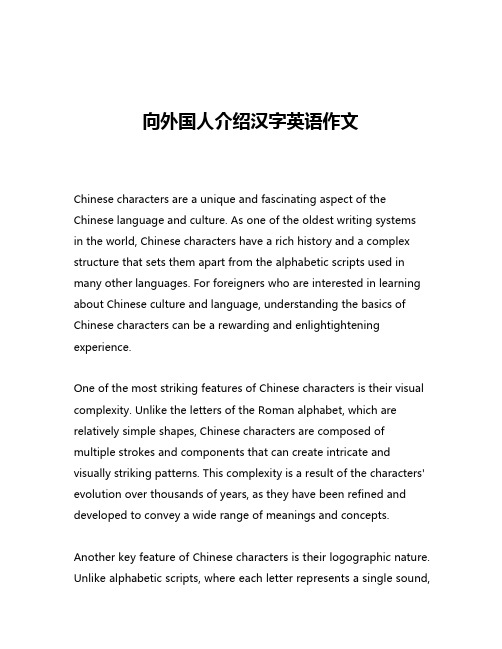
向外国人介绍汉字英语作文Chinese characters are a unique and fascinating aspect of the Chinese language and culture. As one of the oldest writing systemsin the world, Chinese characters have a rich history and a complex structure that sets them apart from the alphabetic scripts used in many other languages. For foreigners who are interested in learning about Chinese culture and language, understanding the basics of Chinese characters can be a rewarding and enlightightening experience.One of the most striking features of Chinese characters is their visual complexity. Unlike the letters of the Roman alphabet, which are relatively simple shapes, Chinese characters are composed of multiple strokes and components that can create intricate and visually striking patterns. This complexity is a result of the characters' evolution over thousands of years, as they have been refined and developed to convey a wide range of meanings and concepts.Another key feature of Chinese characters is their logographic nature. Unlike alphabetic scripts, where each letter represents a single sound,Chinese characters represent entire words or concepts. This means that each character has a specific meaning that is independent of its pronunciation, and that the same character can be pronounced in different ways depending on the context in which it is used.This logographic structure also means that Chinese characters are not organized based on phonetic principles, but rather on the meanings and components that make up each character. This can be a challenge for foreigners who are used to alphabetic scripts, as they may find it difficult to remember the specific shapes and components of each character.Despite these challenges, however, learning to read and write Chinese characters can be a highly rewarding experience. For one, the visual complexity of the characters can be aesthetically pleasing and can even be considered a form of art. Many Chinese characters have intricate designs and patterns that can be appreciated for their beauty and artistry.Moreover, the logographic nature of Chinese characters can also be seen as an advantage in some ways. Because each character represents a complete word or concept, it is often easier to convey nuanced and complex ideas using Chinese characters than it is using an alphabetic script. This can be particularly useful in fields such as philosophy, literature, and the sciences, where precise and nuancedlanguage is essential.Another advantage of Chinese characters is their longevity and universality. Unlike many other writing systems, which have undergone significant changes and transformations over time, Chinese characters have remained largely stable and consistent for thousands of years. This means that the same characters used today are largely the same as those used in ancient times, and that the knowledge and understanding of Chinese characters can be passed down from generation to generation.This longevity and universality also means that Chinese characters are used not only in China, but also in other East Asian countries such as Japan and Korea. While the pronunciation and usage of Chinese characters may vary across these different cultures, the underlying meaning and structure of the characters remains the same. This can be a valuable asset for those who are interested in learning about the broader cultural and linguistic context of the Chinese-speaking world.Of course, learning to read and write Chinese characters is not without its challenges. The sheer number of characters, which can range in the tens of thousands, can be daunting for beginners. Additionally, the complex stroke orders and radicals that make up each character can be difficult to remember and master.However, with dedication and practice, it is possible for foreigners to develop a strong understanding and proficiency in Chinese characters. Many language learners find that the visual and conceptual nature of the characters can actually be an advantage, as it allows them to associate the characters with specific meanings and ideas, rather than just memorizing a series of sounds.Moreover, there are many resources and tools available to help foreigners learn Chinese characters, including dictionaries, flashcards, and interactive language-learning apps. By taking advantage of these resources and practicing regularly, it is possible for anyone to develop a solid foundation in Chinese characters and to use them effectively in a variety of contexts.In conclusion, Chinese characters are a unique and fascinating aspect of the Chinese language and culture that are well worth exploring for foreigners who are interested in learning about this rich and complex tradition. While learning to read and write Chinese characters can be challenging, the rewards of doing so are numerous, from the aesthetic appreciation of the characters themselves to the deeper understanding of Chinese culture and language that comes with mastering this ancient writing system. Whether you are a student, a scholar, or simply someone with a curiosity about the world, learningabout Chinese characters can be a deeply rewarding and enriching experience.。
汉字 英语简介

c. they are firstly symbols of agricultural civilization
integrated with human sentiment, motivation, and history.
Evolutions of Chinese Characters: a historical vestige
B. Ideogrammic compounds 会意字 huì yì zì
• Ideogrammic compounds are also called associative compounds. These characters symbolically combine pictograms or ideograms to create a third character. • For instance, combining 日 rì“sun” and 月 yuè “moon”, the two natural sources of light, makes 明 mí ng “bright”. Other commonly cited examples include the characters 休 xiū “rest”, composed of the pictograms 人 rén “person” and 木 mù “tree”, and also 好 hǎo “good”, composed of the pictograms 女 nǚ “woman” and 子 zǐ "child".
D. Ideograms
• E. Rebus 假借字 jiǎ jiè zì
• Also called borrowings or phonetic loan characters, this category covers cases where an existing character is used to represent an unrelated word with similar or identical pronunciation; sometimes the old meaning is then lost completely, as with characters such as 自 zì , which has lost its original meaning of “nose” completely and exclusively means “oneself”, or 万 wàn, which originally meant "scorpion" but is now used only in the sense of "ten thousand".
介绍我们的汉字英语作文

介绍我们的汉字英语作文Chinese Characters: A Journey into the Heart of a Language.In the tapestry of human civilization, language holds a pivotal place, connecting minds across time and space. Among the world's myriad linguistic treasures, Chinese characters stand as a remarkable testament to the ingenuity and creativity of their creators. These enigmatic symbols, each a miniature masterpiece of calligraphy, have been the lifeblood of a profound civilization for thousands of years.Chinese characters are not mere symbols; they are a living, breathing language with a history that spans millennia. Their origins can be traced back to theenigmatic oracle bones of the Shang dynasty, where diviners etched questions onto animal bones or turtle shells,seeking guidance from the gods. Over time, thesepictographic representations evolved into a complex and comprehensive system of writing, capable of expressing avast array of ideas and emotions.One of the most striking features of Chinese characters is their pictographic nature. Many characters began as simple drawings that depicted real-world objects or concepts. For example, the character for "sun" (日) resembles the orb in the sky, while the character for "mountain" (山) evokes the jagged peaks of a mountain range. This pictographic quality lends Chinese characters a unique visual appeal and helps to make them surprisingly intuitive for native speakers.As Chinese civilization grew more complex, so too didits language. New characters were created to represent abstract concepts and specialized knowledge. For instance, the character for "love" (爱) combines the symbols for "heart" and "double," conveying the idea of a profound emotional connection. The character for "Tao" (道), a key concept in Chinese philosophy, depicts a path or road, symbolizing the search for truth and enlightenment.Chinese characters are more than just symbols; they arevessels of meaning. Each character carries a wealth of historical, cultural, and philosophical significance. For example, the character for "China" (中国) is composed of two parts: "middle" and "country." This reflects the ancient Chinese belief that China was the center of the world, a notion that shaped the country's political and cultural development.The study of Chinese characters is not merely an academic pursuit; it is a journey into the heart of a civilization. By delving into the etymology and symbolism of these characters, we gain a deeper understanding of the Chinese language, culture, and worldview. For instance, the character for "harmony" (和) is composed of the symbols for "mouth" and "grain," suggesting that harmony is achieved through shared dialogue and the provision of sustenance.In the digital age, Chinese characters face new challenges and opportunities. While technology has made it easier to input and transmit characters, the proliferation of simplified characters and the rise of pinyin (a romanization system) have raised concerns about the futureof traditional Chinese writing. Despite these challenges, Chinese characters remain a vital part of Chinese identity and culture, and efforts are underway to preserve and promote their use.In conclusion, Chinese characters are a mesmerizing and multifaceted aspect of human civilization. Their pictographic nature, rich symbolism, and historical significance make them a treasure trove of knowledge and inspiration. By embracing the study of Chinese characters, we unlock a gateway to a deeper understanding of a profound and enduring culture.。
向外国人介绍汉字的作文

向外国人介绍汉字的作文英文回答:Chinese Characters.Chinese characters, also known as Hanzi, are a unique form of writing that has been used for thousands of yearsin China. They are a fundamental part of Chinese culture and language. Let me explain more about Chinese characters.Chinese characters are ideograms, which means that each character represents a specific idea or concept. Unlike alphabets, Chinese characters do not have phonetic sounds. Instead, they convey meaning directly. This is why learning Chinese characters can be quite challenging for non-native speakers.Chinese characters are made up of strokes, which are individual lines or curves. There are basic strokes, such as horizontal, vertical, and diagonal lines, as well asmore complex ones, like hooks and dots. By combining these strokes in different ways, thousands of characters can be created.Each Chinese character is composed of radicals, which are smaller components that give clues to the character's meaning. For example, the radical for "water" is often found in characters related to water, such as "river" or "rain." By understanding radicals, learners can better grasp the meanings of characters and remember them more easily.Chinese characters have evolved over time, and their forms have changed. Traditional characters are still usedin Taiwan and Hong Kong, while simplified characters are used in mainland China. Simplified characters have fewer strokes and are easier to write, but they may differslightly in appearance from their traditional counterparts.Chinese characters are not only used in written language but also in calligraphy, which is considered a form of art. Calligraphy is highly regarded in Chineseculture, and many people practice it as a way to appreciate the beauty of characters and express their artistic skills.中文回答:汉字。
介绍汉字的英文作文
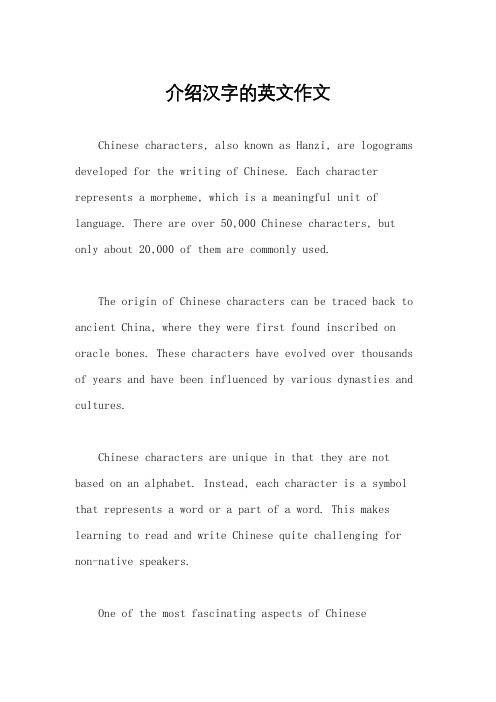
介绍汉字的英文作文Chinese characters, also known as Hanzi, are logograms developed for the writing of Chinese. Each character represents a morpheme, which is a meaningful unit of language. There are over 50,000 Chinese characters, but only about 20,000 of them are commonly used.The origin of Chinese characters can be traced back to ancient China, where they were first found inscribed on oracle bones. These characters have evolved over thousands of years and have been influenced by various dynasties and cultures.Chinese characters are unique in that they are not based on an alphabet. Instead, each character is a symbol that represents a word or a part of a word. This makes learning to read and write Chinese quite challenging for non-native speakers.One of the most fascinating aspects of Chinesecharacters is their visual representation of meaning. Many characters are formed by combining smaller elements, each of which contributes to the overall meaning of the character.In addition to their meaning, Chinese characters also convey pronunciation. This is done through a system called Pinyin, which uses the Latin alphabet to represent the sounds of the characters. This allows learners to understand the pronunciation of characters, even if they are unfamiliar with them.Overall, Chinese characters are a rich and complex system of writing that reflects the depth and diversity of Chinese language and culture. Their beauty and intricacy continue to captivate people around the world.。
英语作文介绍汉字
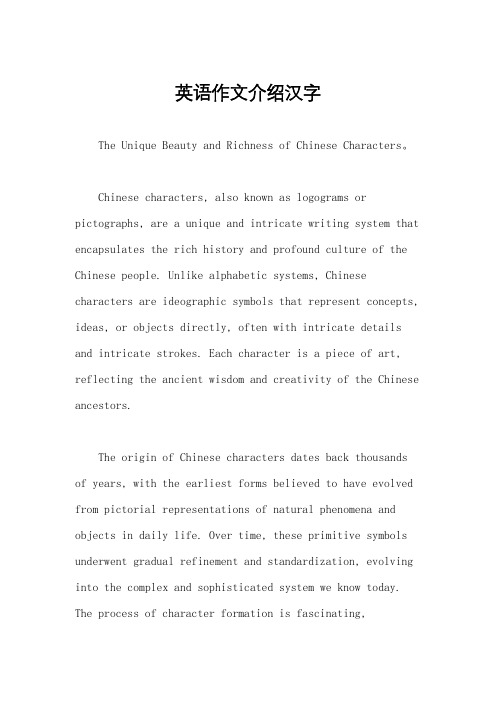
英语作文介绍汉字The Unique Beauty and Richness of Chinese Characters。
Chinese characters, also known as logograms or pictographs, are a unique and intricate writing system that encapsulates the rich history and profound culture of the Chinese people. Unlike alphabetic systems, Chinese characters are ideographic symbols that represent concepts, ideas, or objects directly, often with intricate details and intricate strokes. Each character is a piece of art, reflecting the ancient wisdom and creativity of the Chinese ancestors.The origin of Chinese characters dates back thousands of years, with the earliest forms believed to have evolved from pictorial representations of natural phenomena and objects in daily life. Over time, these primitive symbols underwent gradual refinement and standardization, evolving into the complex and sophisticated system we know today. The process of character formation is fascinating,reflecting the changing social and cultural landscapes of ancient China.One of the most striking aspects of Chinese characters is their visual appeal. Each character is composed of varying numbers of strokes, arranged in intricate patterns and shapes. Some characters are strikingly similar to their real-life counterparts, such as "日" (sun) and "月" (moon), while others are more abstract representations of ideas or sounds. The beauty of these symbols lies in their harmonious balance, elegant curves, and intricate details. Writing Chinese characters is an art form in itself, requiring precision, balance, and a sense of aesthetics.The complexity of Chinese characters also reflects the depth and richness of Chinese culture. Each character is not just a symbol but a carrier of meaning and。
介绍汉字 英语作文
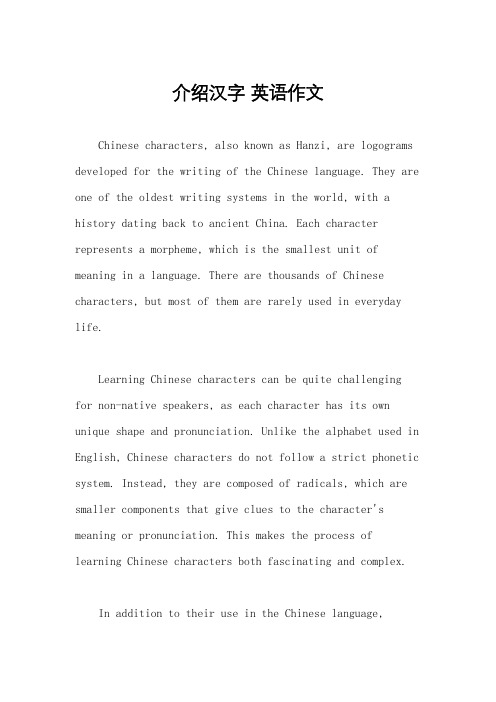
介绍汉字英语作文Chinese characters, also known as Hanzi, are logograms developed for the writing of the Chinese language. They are one of the oldest writing systems in the world, with a history dating back to ancient China. Each character represents a morpheme, which is the smallest unit of meaning in a language. There are thousands of Chinese characters, but most of them are rarely used in everyday life.Learning Chinese characters can be quite challengingfor non-native speakers, as each character has its own unique shape and pronunciation. Unlike the alphabet used in English, Chinese characters do not follow a strict phonetic system. Instead, they are composed of radicals, which are smaller components that give clues to the character's meaning or pronunciation. This makes the process of learning Chinese characters both fascinating and complex.In addition to their use in the Chinese language,Chinese characters have also been adopted by several other East Asian languages, such as Japanese and Korean. Whilethe characters may have similar meanings across these languages, their pronunciations and usage can vary significantly. As a result, many students in East Asia find themselves learning Chinese characters alongside theirnative language, adding an extra layer of complexity totheir education.Despite the challenges, Chinese characters are an essential part of Chinese culture and identity. They are used in a wide range of contexts, including literature, art, and calligraphy. Understanding and appreciating Chinese characters can provide valuable insights into the history and philosophy of Chinese civilization. Whether you are a language enthusiast or simply curious about the world, delving into the world of Chinese characters can be a rewarding experience.。
- 1、下载文档前请自行甄别文档内容的完整性,平台不提供额外的编辑、内容补充、找答案等附加服务。
- 2、"仅部分预览"的文档,不可在线预览部分如存在完整性等问题,可反馈申请退款(可完整预览的文档不适用该条件!)。
- 3、如文档侵犯您的权益,请联系客服反馈,我们会尽快为您处理(人工客服工作时间:9:00-18:30)。
China is the only country in the world with a literature written in one language for more than 3,000 consecutive years.
Reason
This continuity results largely from the nature of the written language itself. It is the use of characters, not letters as in Western languages, that is most important in the Chinese language. The characters stand for things or ideas and so, unlike groups of letters. Thus Chinese could be read by people in all parts of the country in spite of gradual changes in pronunciation, the emer and modification of the characters .
structural units
radic点a击l添s加标题
The basic knowledge in learning Chinese characters includes: strokes, structural units and radicals.
Stroke: is the smallest and the most basic structural
Mutually explanatory
4. With the expansion of civilization, a more complicated method of creating characters developed: Select one existing character to ind点ic击at添e加t标he题 pronunciation, and then integrate it with another existing character to create a new one. More than 90% of Chinese ch点ar击a添ct加e标rs题currently in use were created in this way.
点击添加标题
For example: 水(shuǐ) + 木(mù)
氵+ 木 = 沐(mù) wash
水(shuǐ) + 干(gān)
氵+ 干 = 汗(hàn) sweat
To write Chinese characters, you should know……
点击添加标题
strokes
点击添加标题
刀(d点ā击o添) 加+标丶题=刃(rèn)
knife
点击添加标题
blade
木(mù) + 一=本(běn)
tree
root
one
点击添加t标w题o
点击添up加标题
点击添加标题
down
木(mù) + 一=本(běn)
tree
root
last
Huìyì
Combined-meaning
3. Another method of creating new characters is to integrate two or more existi点ng击c添h加a标ra题cters to create a new character with a new meaning.
The four ways of creating Chinese characters
点击添加标题
xiàngxíng zhǐ shì
h点u击ì添yì加标题 xíngshēng
点击添加标题
xiàngxíng
Pictograms
1. Pictograms characters derive from pictures, they have been standardize点d,击s添im加p标li题fied, and stylized to make them easier to write, and their derivation is there点fo击re添n加o标t 题always obvious. Examples include for sun for 点击添加标m题oon, and ľ for tree.
丿
right-falling
㇏
rising
㇀
a bending stroke 乙、乚、乛
hook
亅
unit of Chinese characters, consistin点g 击of添d加ot标s 题and lines.
点 diǎn
横 héng
竖 shù
撇 piě
捺 nà 提 tí 折 zhé 钩 gōu
dot
丶
horizontal strok点e击添加一标题
vertical stroke
丨
l点ef击t-添fa加lli标ng题
点击添加标题
For example: 日(rì) sun +月(y点u击è)添n加o标on题=
明 (míng ) bright
木(mù) +木(mù) tree, wood = 林 (lín) forest
huìyì
点击添加h标a题ve a rest
点击添加标题
点击添加标题
hot
Xíng shēng
zhǐ shì
Self-explanatory
2.Based on the pictographic characters, Chinese people added more strokes to an existing character to indicate abstract点m击e添a加n标in题gs.
